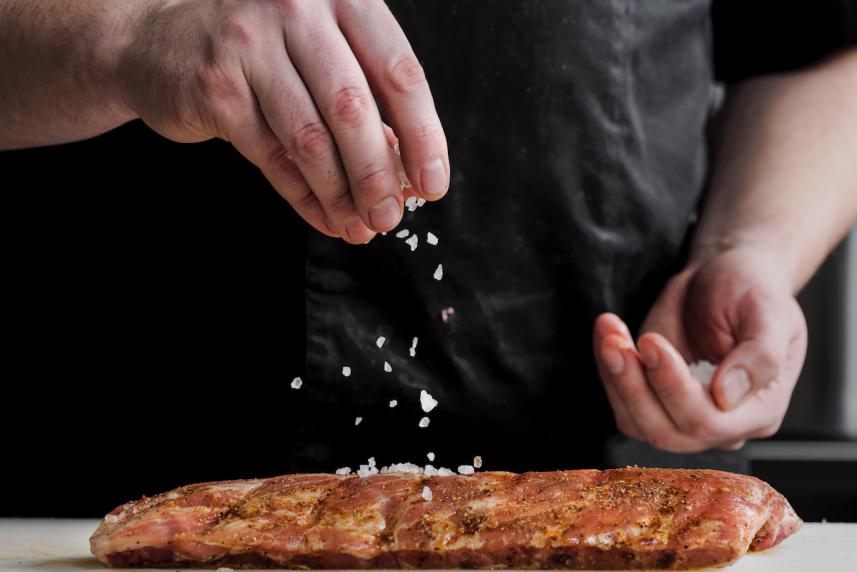3 Techniques for Tasty Meals
Cook like a chef with these skills that maximize flavor but not calories

You don’t have to be a trained chef to enjoy a five-star meal, and you don’t have to sacrifice flavor for health. You and your kitchen are capable of mastering techniques that are sure to wow your taste buds without overwhelming your waistline. Julie Burba, assistant director of education at the Cambridge School of Culinary Arts in Cambridge, Massachusetts, shares how you can master three healthy cooking techniques: searing, braising, and reducing.
SEARING
Searing meat is all about adding flavor without adding extra ingredients (read: calories). The heat from the pan sends the sugar in the meat to the surface to create that brown, crusty, yummy exterior.
What it’s good for: Loin cuts of beef or pork.
Tools you need: A skillet (either nonstick, stainless steel or cast iron), metal tongs.
How it works: Start by bringing your meat to room temperature to make sure the meat cooks evenly and has a nice texture. Season both sides with salt and pepper. Skim the surface of your skillet with fat like olive or vegetable oil and bring it to medium heat. Place your meat in the skillet and don’t be afraid of the sizzle; the browning happens immediately. When the bottom side is brown, flip the meat and sear the other side.
When the other side of the meat is brown, finish cooking it in your oven. Put your skillet in the oven if it’s oven-safe, or put the meat on a cookie sheet or jelly roll pan (covering the sheet or pan in foil first means less cleanup later, too). Set your oven to 350 degrees and once your meat is in, check it for doneness either by sight or with an instant read thermometer. You can tell by sight if your meat is done by looking at the juices. If the juices run pink, your meat is on the medium side and if the juices are running clear, your meat is nearing well done. Check on it in 5 minutes because even a thick cut of steak won't need too long.
Tricks of the trade: Searing only takes minutes, so the key is to not disturb the meat while it’s in the pan – poking it, lifting it and peeking underneath constantly. The meat is ready to be flipped when it can slide around easily in the pan. Use tongs to gently nudge the meat to see how easily it slides. If it’s not stuck to the pan, it’s ready to flip.
BRAISING
A slow and moist form of cooking, braising can turn even the toughest meats into tender bites of melt-in-your-mouth goodness. It does require some time depending on the amount of meat you’re cooking (anywhere from an hour to three to five), but the results are oh so worth it.
What it’s good for: Tough cuts of meat, such as from the shoulder or hindquarters. Those muscles work the hardest, which means they’re full of connective tissue that require lots of time and moisture to make them edible. Roasts, ribs, and chicken legs and thighs taste great after braising. Bonus: Since tougher meats are seen as less desirable, they’re typically inexpensive.
What you need: A covered, oven-safe pot (like a Dutch oven), tongs, and a wooden spatula.
How it works: Every good braise starts with searing. You can sear your meat in the same pot that will go in the oven to cut down on equipment and cleanup. After you’ve seared your meat, set it aside and deglaze the pan. “Deglazing” is a nicer way of saying “scraping.” Add a little cooking stock, broth, water, or even wine to the pan, depending on your recipe, and use the wooden spatula to scrape up the bits of meat stuck to bottom of the pan. Those bits of meat may not seem like much, but when added to your braising liquid, they kick the flavor up another notch.
Pour the deglazed liquid from the pan into your braising liquid, which again, could be stock, broth, water, or wine. Add the now-enhanced braising liquid and meat back to the pan, with the meat halfway submerged in the liquid, no more and no less. For extra flavor, add vegetables like carrots, mushrooms, and onions. Cover the pot and put in the oven on 325 degrees. Depending on how much meat you’re working with, your meat could spend up to five hours in the oven. You’ll know it’s done when the meat is moist, tender, and falls off the bone.
Tricks of the trade: Water in the oven boils at 350 degrees, so while you may be tempted to crank up the heat to cook faster, you don’t want to risk boiling your braise. Trust us, braised meats are worth the wait.
REDUCING
Your seared, braised meat is now full of flavor, but what goes better with flavorful meat than a flavorful sauce? A pan reduction sauce using your searing pan and braising liquid is easy to make and doesn’t need extra fats or starches.
What you need: A skillet (nonstick, stainless steel, or cast iron), a wooden spatula
How it works: After you’ve seared meat in the skillet, deglaze the skillet with a bit of liquid like stock, broth, wine, or water. Then add more stock to the pan and bring it to a boil. Let the liquid cook down until it reaches a thick, sauce consistency. From there, add seasonings to your heart’s desire.
Tricks of the trade: Pan reduction sauces don’t need starch or fat to thicken them up. You’re reducing the water from your stock, leaving behind a gelatinous sauce that will compliment the meat.



